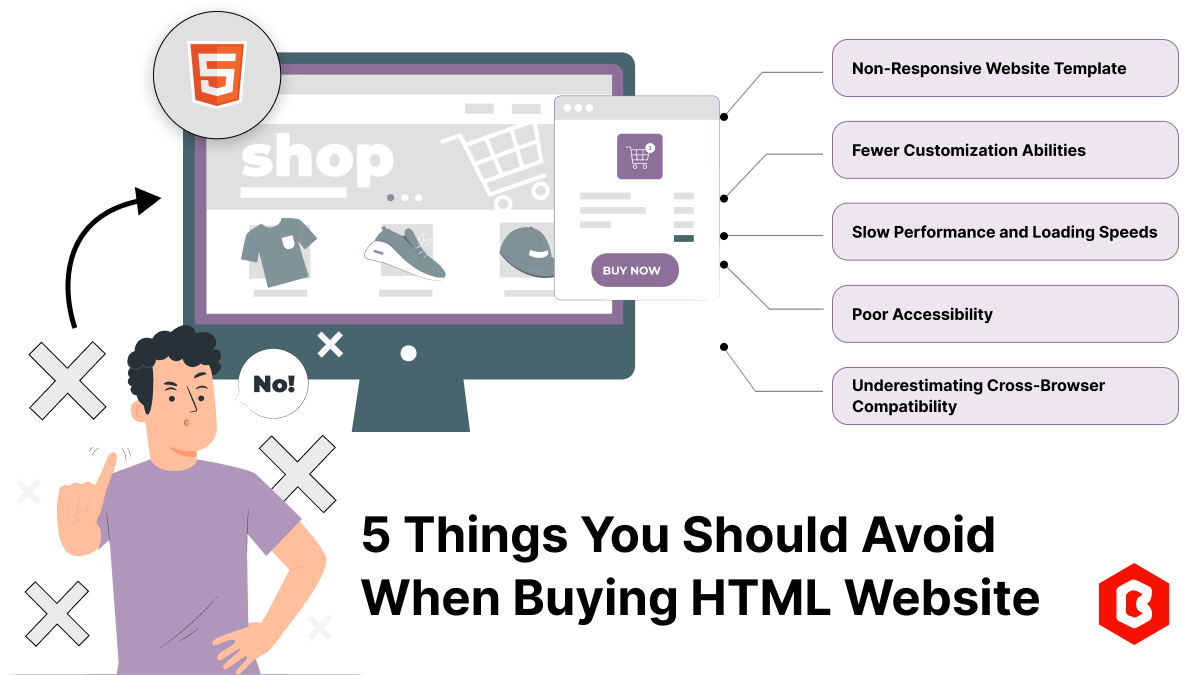Black Friday Special! Buy any 1 product and get 1 absolutely free — this offer applies to all Website Templates, UI Kits, and Complete Scripts.
Buy Now!
According to stats published on Forbes, 57% of internet users avoid recommending a poorly designed website, especially on mobile devices. Another trend of building websites using HTML website templates is going wild because they are easy to use and speed up the web development process at affordable prices.
However, the stats mentioned above cannot be ignored, especially when you’re choosing a website template for your business. Apart from the website template design, there are some other aspects to consider while purchasing a template. So, we’ll talk about five things to avoid when buying an HTML website template in this article.
First of all, let’s understand what’s a responsive website template. So, the responsive template refers to a website template that can work flawlessly across desktop, laptop, tablet, and mobile devices. It’s optimized to let you create a website that works smoothly on all screen sizes.
Over 58% of website traffic comes from mobile devices, making a responsive web design essential. A non-responsive website template will appear poorly on smartphones and/or tablets, which may spoil the user experience on such devices and increase bounce rates. For example, if you own an eCommerce site that doesn’t display products correctly on mobile screens, it will make your potential customers leave your website without making a purchase. So, it is advised to prioritize website templates that can adjust to various screen sizes accordingly.
More than half of companies invest in design to differentiate their brands. No website template completely matches your requirements. You may need to make a few customizations to match it accurately to your concept. So, it’s advised to look for highly customizable templates.
Imagine a website template, in which you can customize content but not design or logo. Such fewer customization abilities might force you to settle for a generic appearance, preventing you from including your brand’s unique look and feel. Always look for customizable templates that allow easy adjustments to fonts, colors, and layout elements, giving you more control over your site’s appearance.
Some HTML templates are packed with excessive animations, large-sized images, or poorly optimized code, which may result in significant delays, causing slow performance and high page loading speeds.
53% of mobile site visitors will press the back button if a web page takes longer than 3 seconds to load. Consider a visually attractive-looking portfolio site built with a template, which moves or operates more slowly than usual and may lose potential clients before they can view your work. So, always prefer a light and fast-loading HTML website template to increase your website’s visibility among the target audience.
Imagine a template that doesn’t support screen readers or doesn’t allow text resizing. It may negatively affect visually challenged users. A website based on such a template will let you lose a large number of audience.
According to the World Health Organization, over 1 billion people live with some form of disability, and a website that lacks accessibility features will exclude a large portion of this audience. So always prefer choosing a template that sticks to WCAG (Web Content Accessibility Guidelines) standards, which offers features like keyboard navigation and properly labeled elements that can also provide a reliable user experience to an audience with some form of disability.
Cross-browser compatibility refers to making your website compatible with various browsers. Over 60% of internet users prefer using Chrome as a primary browser, but optimizing your website only for Chrome isn’t sensible.
It’s true that more than half of internet users prefer Google Chrome, but millions still rely on other browsers such as Safari, Firefox, and Microsoft Edge. A template that only performs well on one browser can create inconsistent experiences for those using different platforms. For example, a site that looks polished in Chrome might break or appear distorted in Firefox. Before purchasing, ensure the template has been tested across multiple browsers or offers you easy optimizations for cross-browser compatibility.
When choosing an HTML website template for your business, you have so many factors to look for apart from an attractive web design. By avoiding non-responsive templates, those with limited customization, slow performance, poor accessibility, and cross-browser compatibility, you ensure a seamless and inclusive experience for all or most visitors. Take the time to deeply test your options and choose an HTML website template that meets the needs of your business and audience. It will set a strong foundation for a successful online presence.
Picking the perfect style for your website is a major decision, especially in the vast scope of web...
Designing and developing a website may look tough and time-consuming. It is actually tough when it c...
Developing a website has now been important to reach a wider audience. Performing web development fr...
Having an interactive and functional website is a core aspect of making a successful online business...
When the world is going online, having a responsive website that works flawlessly across all devices...
Search Engine Optimization (SEO) is an important part of digital marketing that can help your websit...

Not sure which template or UI kit fits your project? Reach out for expert advice.